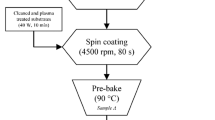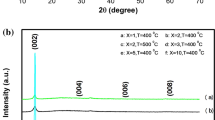Abstract
Thin films of MoS x have been prepared on silicon substrates by spin coating and thermolysis of 0.5 M solutions of alkyldiammonium tetrathiomolybdates in 1,2-ethanediamine (EDA) and 1,2-propanediamine (12PDA). The films have been heat treated in air at temperatures between 80 and 250°C and under N2 atmosphere at temperatures between 300 and 800°C. X-ray diffraction shows a restricted crystallisation and amorphous residues in both kind of films. EDA-based films exhibit a high tendency to crystallise whereas 12PDA-based films form associated structures with the solvent preventing precursor crystallisation. An insight into the processes occurring in film formation is gained by infrared spectroscopy which indicates a beginning of the decomposition of the 12PDA-based film at temperatures as low as 80°C with incorporation of the diamine solvent. In contrast, the EDA-based films show first signs of a decomposition at 150°C. The decomposition of the intermediate MoS3 in both cases starts between 250 and 300°C. By means of SNMS depth profiles carbon contents up to 21 and 32 atom-% were found in EDA- and 12PDA-based films, respectively. The films show a significant deficit of sulphur which is compensated by the carbon. Near the surface of the coatings a loss of carbon is observed.
Similar content being viewed by others
References
A.R. Landsdown, Molybdenum Disulphide Lubrication (Elsevier, Amsterdam, 1999).
S.K. Srivastava and B.N. Avasthi, J. Mater. Sci. 28, 5032 (1993).
A. Aruchamy, Photoelectrochemistry and Photovoltaics of Layered Semiconductors (Kluwer Academic Publishers, Dordrecht, Boston, London, 1992), p. 1.
V. Buck, Wear 114, 263 (1987).
J. Cheon, J.E. Gozum, and G.S. Girolami, Chem. Mater. 9, 1847 (1997).
K.C. Mandal and O. Savadogo, Jpn. J. Appl. Phys. 1 30, 3484 (1991).
E.A. Ponomarev, R. Tenne, A. Katty, and C. Lévy-Clément, Sol. Energy Mater. 52, 125 (1998).
J. Pütz and M.A. Aegerter, Thin Solid Films 351, 119 (1999).
C.Y. Kuo, Solid State Techn. 2, 49 (1974).
G.R. Paz-Pujalt, W. Nie, and C. Lurin, Materials Research Society Symposium Proceedings, Vol. 271: Better Ceramics through Chemistry V (MRS, San Francisco, 1992), p. 193.
S. Dhingra and M.G. Kanatzidis, Materials Research Society Symposium Proceedings, Vol. 180: Better Ceramics through Chemistry IV (MRS, 1990), p. 825.
N.P.G. Roeges, A Guide to the Complete Interpretation of Infrared Spectra of Organic Structures (John Wiley & Sons, New York, 1994).
C.H. Chang and S.S. Chan, J. Catal. 72, 139 (1981).
Author information
Authors and Affiliations
Rights and permissions
About this article
Cite this article
Pütz, J., Aegerter, M. MoS x Thin Films by Thermolysis of a Single-Source Precursor. Journal of Sol-Gel Science and Technology 19, 821–824 (2000). https://doi.org/10.1023/A:1008728604305
Issue Date:
DOI: https://doi.org/10.1023/A:1008728604305




